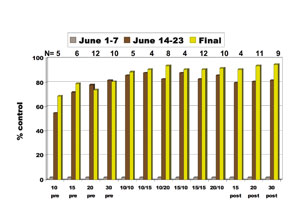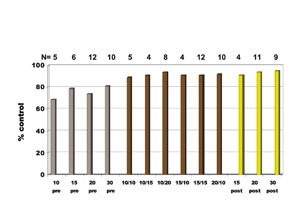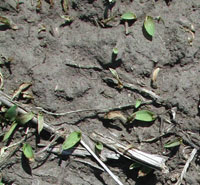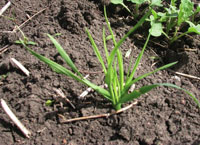
Features
Agronomy
Weeds
Pre-seed burnoff research could offer extended grassy weed control
An Everest-glyphosate pre-seed tank-mix could offer multiple advantages.
October 9, 2008 By Bruce Barker
An Everest-glyphosate pre-seed tank-mix could offer multiple advantages.
Research into a better way to control wild oats might just change the way farmers approach a pre-seed burnoff. Ken Sapsford at the University of Saskatchewan, along with Eric Johnston at Agriculture and Agri-Food Canada at Scott, have spent the last three years looking at whether Everest could be used as a pre-seed or pre-emergence burndown in a glyphosate tank-mix, and provide season long wild oats and green foxtail control as a bonus.
“Based on our previous research, we knew that Everest had soil residual properties, so we thought we might be able to put that to work in a pre-seed application,” explains Sapsford. Recognizing that Everest would not provide control of all pre-seed weed problems, the researchers used a tank-mix with glyphosate to provide a complete burndown. Conversely, Everest also has the potential to control volunteer Roundup Ready canola in the pre-seed burndown.
Currently, Everest is registered on wild oats, green foxtail, red root pigweed, wild mustard, stinkweed, volunteer canola (except Clearfield types) and green smartweed in a post-emergence application.
The researchers looked at two types of pre-seed treatments compared to the standard post-emergence treatment. Everest was applied as either a pre-plant or pre-emerge burndown, in a split treatment pre- and post-, and as a post-emergence treatment only. Various rates were also used in each treatment.
 |

|
| Figure 1. Wild oats control rating. Source: Ken Sapsford, University of Saskatchewan |
Figure 2. Wild oats control. Source: Ken Sapsford, University of Saskatchewan |
Split application opens up options
Looking at the results from the 12 trials, none of the Everest rates applied as a pre-seed burndown provide acceptable season-long control in every year. While the 30 gram active ingredient (gai) rate had an average wild oats control of approximately 80 percent, (80 percent or more is the definition of commercially acceptable control), this rate only achieved that level in approximately 70 percent of the years. So from a wild oats control perspective, a pre-seed burndown application was not going to cut it every year.
 |
| Green foxtail with Everest injury. |
 |
| Everest injury on wild oats with yellow new growth. |
 |
| Everest injury end of June. First two leaves looking darker with red tinge and new leaves are chlorotic. |
 |
| Everest injury on wild oats showing striped new growth. Photos courtesy of Ken Sapsford, University of Saskatchewan |
However, Sapsford explains that the pre-seed application of 15 grams still gave adequate control 50 percent of the time. That got him thinking that when the 15 gram rate is applied pre-seed, half the time he might not need to go back and spray post-emergence. In essence, the Everest pre-seed burndown with glyphosate also provided season-long control of wild oats for about the cost
of a pre-seed burndown. The other half of the time, a post-emergence Everest application of 15 grams would be necessary to improve wild oats control.
“If I have a light infestation of wild oats and use the pre-seed split approach, I might not need to go back and spray post-emergently for wild oats,” says Sapsford. “That can save on herbicide costs. The other 50 percent of the time, I would have to go in and spray, but I would have had to control those wild oats anyway, so I’m not out any additional cost.” Another advantage of the split application is that it may also help protect yield by keeping the crop cleaner during the early seedling stage.
While all the split combinations had similar wild oats control, the 15/15gai pre/post split is likely where the best combination lies, because it provided a more dependable wild oats control with the pre-seed burndown over the years.
Brian Schilling, technical services manager with Arysta LifeScience, says the company has received registration of the 15/15 split application in the US and will be calling the product Pre-Pare. In Canada, where an Everest label extension has also been applied for, the company has applied to register 10/20, 15/15 and 20/10 split applications.
To take advantage of the split approach, Sapsford says growers will need to sharpen their scouting skills to be able to identify Everest activity on wild oats and green foxtail. During the first week of June when many growers start to spray, wild oats control was virtually non-existent with the pre-seed applications. Yet by mid to late June, the pre-seed applications were showing nearly 80 percent control.
“If you didn’t know the symptoms of activity, you might spray the wild oats when you didn’t need to,” explains Sapsford. “The wild oats can get to the three leaf stage before you can see symptoms. As a crop scout, you might think they needed to be sprayed, but you need to wait for the four leaf stage to see if they will keep growing, or dry up and die.”
Typical Everest pre-seed symptoms on wild oats include yellowing and striping of the newest leaves and stunted plants later in the year. The first three leaves may appear normal, and the emerging leaves are yellow and dying off. Schilling says the company is also looking at whether Everest enhances glyphosate control of other weeds.
To-date, they have noticed the pre-seed application improves weed control in some years and locations, and on some weeds. The tank-mix is with the labelled rates of glyphosate. “The advantage of the pre-seed tank-mix approach is that it keeps fields clean, longer,” says Schilling.